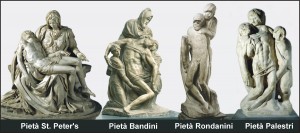There are very solid reasons why many avoid the mold and clay making process. Its expensive and risky. Several months have been invested just to get to this moment where actual clay can be formed into a new statue. Just think of the risk of wasting all this time and money toward a goal that hasn’t proved its value. And worse yet, the original maquette has been destroyed while making the plaster impression. The payoff is in the hope that subsequent clay castings will provide the means to sell several ‘originals’. If your successful, these multiple statues will help overcome the original costs, and ideally create a modest profit. So goes the theory.
My 18 piece mold can support either a slip casting or a pressed clay process. However, as my Pieta Amare design is very tall, over 26 inches, there is a real possibility that the liquid slip clay may collapse from its own weight before it has the time to harden and set. Weight will not be an issue with pressed paper clay. The thickness of the clay can also be adjusted with the lower third of the statue being pressed to a one inch thickness wile the upper sections being limited to half inch or less.















